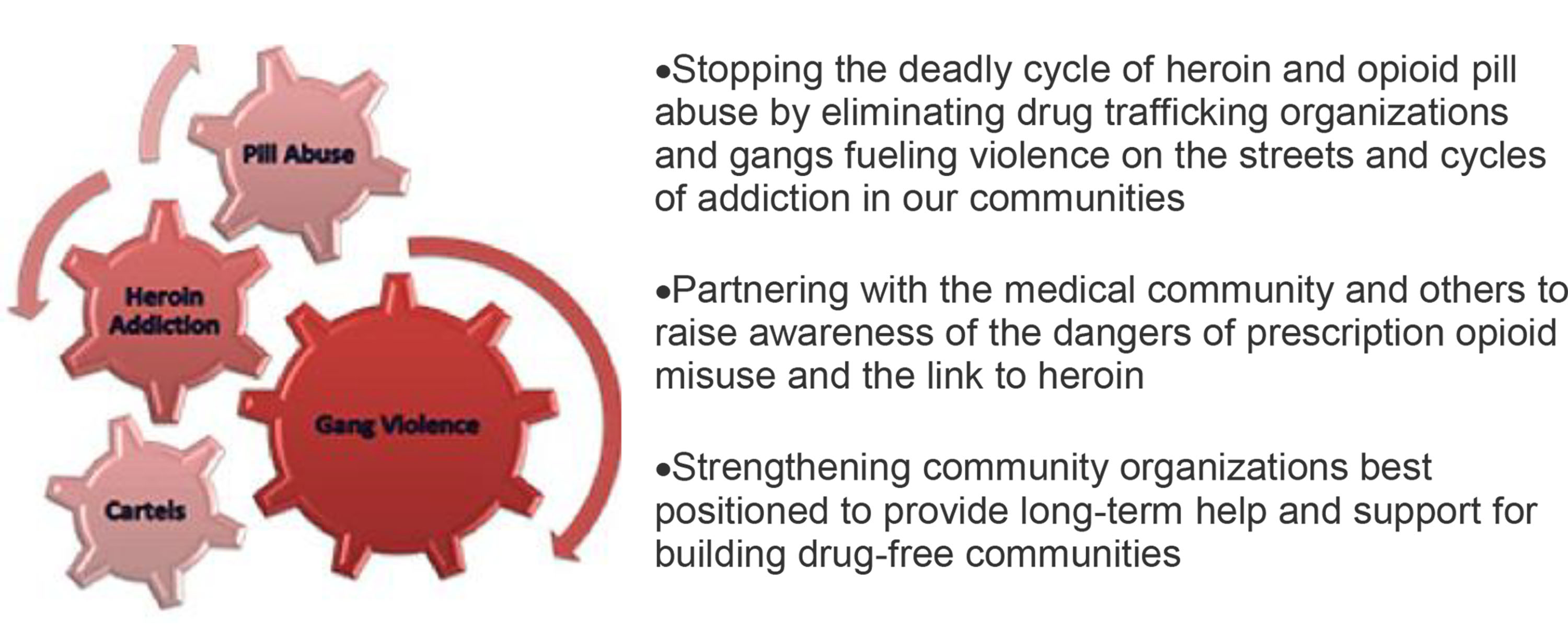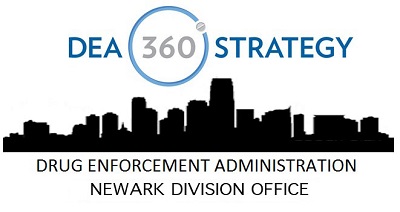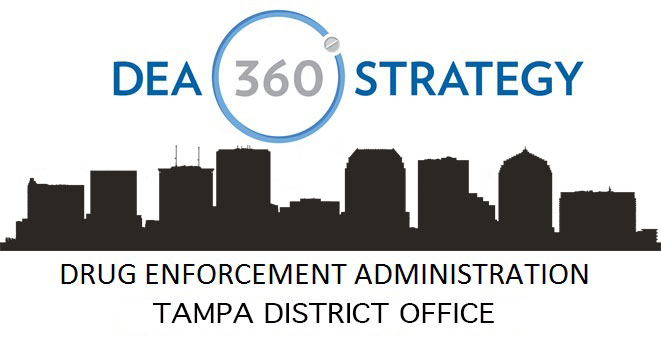Overview
DEA’s 360 Strategy responds to the heroin and prescription opioid pill crisis. The 360 Strategy takes an innovative three-pronged approach to combating heroin/opioid use through:

(1) Coordinated Law Enforcement actions against drug cartels and heroin traffickers in specific communities;
(2) Diversion Control enforcement actions against DEA registrants operating outside the law and long-term engagement with pharmaceutical drug manufacturers, wholesalers, pharmacies, and practitioners; and
(3) Community Outreach through local partnerships that empower communities to take back affected neighborhoods after enforcement actions and prevent the same problems from cropping up again.
DEA rolled out the 360 Strategy in November 2015 in Pittsburgh together with the U.S. Attorney and state and local partners. Since that time, DEA has deployed the strategy in other pilot cities and is using the three-pronged approach in all DEA Field Divisions.

A comprehensive approach tackling the cycle of violence and addiction generated by the link between drug cartels, violent gangs, and the rising problem of prescription opioid and heroin abuse in U.S. cities. DEA 360 involves:
- Coordinated Law Enforcement operations targeting all levels of drug trafficking organizations and violent gangs supplying drugs to our neighborhoods
- Engaging drug manufacturers, wholesalers, practitioners, and pharmacists through Diversion Control to increase awareness of the opioid epidemic and encourage responsible prescribing practices, and use of opioid painkillers throughout the medical community
- Community Outreach and partnership with local organizations following enforcement operations, equipping and empowering communities to fight the opioid epidemic
Goals

360 Strategy Reach and Impact Reports
These reports describe the methods and results of an assessment of the reach and impact of community outreach activities of the DEA 360 Strategy across several cities. Results are based on a summary of metrics from DEA’s national partners on the 360 Strategy, as well as from phone interviews with community partners and DEA leaders in each city.
Milwaukee (Wisconsin) Manchester (New Hampshire)
Salt Lake City (Utah) Charleston (West Virginia)
Newark (New Jersey) Los Angeles
National and Federal Partners
- Department of Justice: Office of Justice Programs (OJP)
www.ojp.gov
The Office of Justice Programs (OJP) provides innovative leadership to federal, state, local, and tribal justice systems, by disseminating state-of-the art knowledge and practices across America, and providing grants for the implementation of these crime fighting strategies. Because most of the responsibility for crime control and prevention falls to law enforcement officers in states, cities, and neighborhoods, the federal government can be effective in these areas only to the extent that it can enter into partnerships with these officers.
- Department of Justice: Violence Reduction Network (VRN)
https://www.bja.gov/Programs/VRN.html
The Violence Reduction Network is an innovative approach to support and enhance local violence reduction efforts. This data-driven, evidence-based initiative complements DOJ’s Smart on Crime initiative through delivery of strategic, intensive training and technical assistance. Designed to enhance a site’s current goals, VRN builds on efforts already under way, leverages lessons learned, and delivers a broad spectrum of resources via a strategic and holistic approach.
- Department of Health & Human Services (HHS): Substance Abuse Mental Health Services Administration (SAMHSA)
http://www.samhsa.gov/
The Substance Abuse and Mental Health Services Administration (SAMHSA) is the agency within the U.S. Department of Health and Human Services that leads public health efforts to advance the behavioral health of the nation. SAMHSA's mission is to reduce the impact of substance abuse and mental illness on America's communities. SAMHSA promotes and implements prevention and early intervention strategies to reduce the impact of mental and substance use disorders in America’s communities.
Center for Substance Abuse Prevention (CSAP)
The mission of the Center for Substance Abuse Prevention is to improve behavioral health through evidence-based prevention approaches. Center for Substance Abuse Treatment (CSAT)
The mission of the Center for Substance Abuse Treatment is to promote community-based substance abuse treatment and recovery services for individuals and families in every community. CSAT provides national leadership to improve access, reduce barriers, and promote high quality, effective treatment and recovery services.
- Centers for Disease Control & Prevention (CDC)
http://www.cdc.gov/
CDC remains committed to advancing a public health approach to preventing drug overdose death and applies its scientific expertise to help curb the epidemic in three ways: improving data quality and surveillance to monitor and respond to the epidemic; strengthening state efforts by scaling up effective public health interventions; and equipping health care providers with the data and tools needed to improve the safety of their patients
- Community Anti-Drug Coalitions of America (CADCA) www.cadca.org
CADCA is the premier membership organization representing those working to make their communities safe, healthy, and drug-free. CADCA has members in every U.S. state and territory and is working in 18 countries around the world. Special programs within CADCA are supporting returning veterans and their families and training youth leaders to be effective agents of change –all through the coalition model. Since 1992, CADCA has demonstrated that when all sectors of a community come together —social change happens.
- DEA Educational Foundation http://www.deaeducationalfoundation.org/
Established in 2001, the DEA Educational Foundation educates the American public on the various costs and consequences of drugs on society through support of the educational programs and exhibits of the DEA Museum and the operation of DEA Youth Dance Program in more than 30 cities around the country.
- Benevolent and Protective Order of the Elks www.elks.org/dap
The Elks National Drug Awareness Program, established in 1982, is the largest volunteer drug awareness program in the United States. The Elks are committed to eliminating the use and abuse of illegal drugs by all members of society and believe that in order to ensure a bright future for our country, it is essential that our children be raised in a drug-free environment. The Elks possess a dedicated army of volunteers who freely give their time and talents to what they describe as “a most noble cause.”
- Boys & Girls Clubs www.bgca.org
The mission of Boys & Girls Clubs is to enable all young people, especially those who need us most, to reach their full potential as productive, caring, responsible citizens. A Boys & Girls Club provides: a safe place to learn and grow; ongoing relationships with caring, adult professionals; and life-enhancing programs and character development experiences. Their community-based Delinquency and Gang Prevention/Intervention Initiative targets young people ages 6 to 18 that are at high risk for involvement or are already involved with delinquency and gangs. These youth and teens are directed to positive alternatives and learn about violence prevention.
- Boy Scouts & Girl Scouts of America www.scouting.org; www.girlscouts.org
About: Boy Scouts -- One of the nation's largest and most prominent values-based youth development organizations. The BSA provides a program for young people that builds character, trains them in the responsibilities of participating citizenship, and develops personal fitness. For over a century, the BSA has helped build the future leaders of this country by combining educational activities and lifelong values with fun.
The Boy Scouts of America believes — and, through over a century of experience, knows — that helping youth is a key to building a more conscientious, responsible, and productive society. Drugs: A Deadly Game! is the drug abuse prevention awareness program of the Boy Scouts of America. It is a drug education experience designed to stimulate discussion in small groups and classroom settings and to get children talking—and learning—about the dangers of drug use and abuse.
About: Girl Scouts builds girls of courage, confidence, and character, who make the world a better place. Girl Scouts sees itself as the preeminent leadership development organization for girls. With programs for girls from coast to coast and across the globe, Girl Scouts offers every girl a chance to do something amazing.
- Partnership for Drug-Free Kids (Partnership) www.drugfree.org
Founded in 1987 as an anti-drug advertising campaign and formerly known as the Partnership for a Drug-Free America, the Partnership is a nonprofit organization dedicated to reducing teen substance abuse and helping families impacted by addiction. The Partnership for Drug-Free Kids translates the science of teen drug use and addiction for families, providing parents with direct support to prevent and cope with teen drug and alcohol abuse. On their website, families can find the information they need to understand the ever-changing drug landscape, which now includes abuse of prescription drugs. In addition to support and resources for parents, Partnership reaches youth directly through teen-targeted efforts.
- Young Marines (YM) www.youngmarines.com
The Young Marines (YM) program is a youth education and service program for boys and girls ages 8 through completion of high school. It promotes the mental, moral, and physical development of its members. The program focuses on building character, developing leadership, and promoting a healthy, drug-free lifestyle. This is a national program with 300 units throughout the United States. - Lions Club International Foundation (LCIF)http://www.lcif.org/
LCIF works to support the efforts of Lions clubs and partners including DEA in serving communities locally and globally, giving hope and impacting lives through humanitarian service projects and grants. They are a DEA partner in the DEA 360 strategy, the Red Ribbon Campaign, National Take Back Days, Operation Prevention, and many other DEA initiatives. - National Police Athletic/Activities League, Inc. http://www.nationalpal.org/
The National Police Athletic/Activities League, Inc., (PAL) is a youth mentoring organization that uses civic, educational, athletic and recreational activities to create trust and understanding between law enforcement and youth. PAL emphasizes that life is about making choices and it is important to build this foundation at an early age. Using role model reinforcement, PAL -- under the supervision and positive influence of law enforcement -- guides youth down a path of making “good choices.” Annually, PAL serves more than 1.5 million youth, ages 5-18, with more than 300 member Chapters world-wide.

























